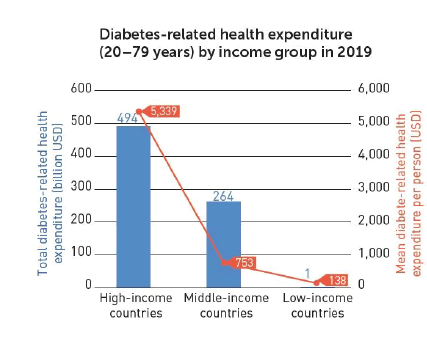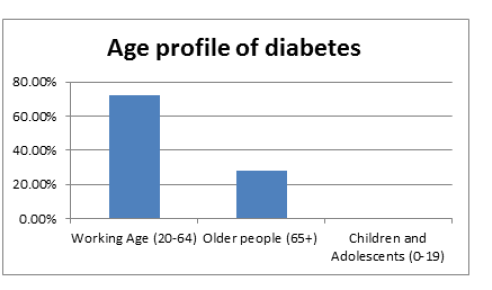29th European Diabetes Congress: Today’s Market Study of Diabetes in USA | Europe | Middle East | Asia Pacific
“ 29th European Diabetes Congress ” is going to be held during June 15-16, 2020 Barcelona, Spain. The Conference will be organized around the theme “ New technologies and practical approaches: Diabetes and Endocrine disorders ” highlighting the latest and exciting innovations in Diabetes Disease& Treatment. Euro Diabetes 2020 Conference invites all Academic Scientists, Leading Endocrinologists, Surgeons, Oncologists, Radiation Therapists, General Physicians, Dieticians, Primary Health care specialists, Internists, Pharmaceutical Industrial Delegates, talented young scientists, and student communities across the globe to attend European Diabetes conference under a single roof where networking and global partnering happens for the acceleration of future research.
Today’s Market Study of Diabetes in USA | Europe | Middle East | Asia Pacific
Europe: The number of people living with diabetes in Europe is expected to increase from 52 million in 2014 to 68.9 million by 2035, according to the International Diabetes Federation (IDF). Across Europe, around 1 in 11 adults is affected and this
USA: Diabetes Mellitus has been growing at an exponential rate and World Health Organization (WHO) estimates that the diabetic population is likely to reach 366 million in 2030. The United States is expected to have an increase of 102 percent in the diabetic epidemic in 2030 when compared to 2000
Middle East: The rate of diabetes in parts of the Arabian Peninsula is over twice the global average rate, and much higher than some other areas of the Middle East and North Africa (MENA). And cases of type-2 diabetes outnumber cases of type-1 diabetes by a ratio of 10:1
Asia Pacific: The Asia-Pacific Diabetes Care Devices Market has been estimated at USD 2.461 Billion in 2015 and is projected to reach USD 3.518 billion by 2020, at a CAGR of 7.41% during the forecast period from 2015 to 2020
Diabetes is one of the fastest growing health challenges of the 21st century, with the number of adults living with diabetes having more than tripled over the past 20 years. In 2000, the global estimate of adults living with diabetes was 151 million. By 2009 it had grown by 88% to 285 million. Today, we calculate that 9.3% of adults aged 20–79 years – a staggering 463 million people – are living with diabetes. A further 1.1 million children and adolescents under the age of 20 live with type 1 diabetes. A decade ago, in 2010, the global projection for diabetes in 2025 was 438 million. With over five years still to go, that prediction has already been surpassed by 25 million will be 578 million adults with diabetes by 2030, and 700 million by 2045.

Type 1 diabetes is caused by an autoimmune reaction in which the body’s immune system attacks the insulin-producing beta cells of the pancreas. As a result, the body produces very little or no insulin.
Type 2 diabetes is the most common type of diabetes. Initially, hyperglycaemia (high blood glucose levels) is the result of the inability of the body ’ s cells to respond fully to insulin, a situation termed ‘insulin resistance’.
Gestational diabetes (GDM) is characterized by high blood glucose levels during pregnancy. It may occur at any time during pregnancy. Women who experience GDM face an increased risk of developing type 2 diabetes later in life. In addition, babies born to mothers with GDM also have a higher lifetime risk of obesity and developing type 2 diabetes themselves. This contributes to an intergenerational cycle of obesity and diabetes that seriously impacts the health of the entire population, and the generations to come.
Impaired glucose tolerance (IGT) is a condition of raised blood glucose levels above the normal range, but below the recommended diabetes diagnostic threshold. The terms ‘prediabetes’ and ‘non-diabetic hyperglycaemia’ are sometimes used as alternatives.
IGT is important because it:
• Indicates a risk of developing type 2 diabetes in the future;
• Denotes an already heightened risk of cardiovascular diseases;
• Offers the opportunity for interventions that can lead to the prevention of type 2 diabetes. The estimated number of adults with IGT, and therefore at increased risk of developing type 2 diabetes, is 374 million. It is predicted to rise to 454 million by 2030 and to 548 million by 2045.
Insulin: Launch of generic versions of insulin and extensively growing demand for novel insulin in controlling the blood sugar levels in both type 1 and type 2 diabetes ate factors anticipated to fuel the growth of insulin segment in the market during the forecast period. In march 2019 Eli Lilly (key player) and company launched Lispro, a generic version of rapid-acting Humalog insulin which shall be available in the US by making it more accessible for diabetic patients. Additionally, growing investments in research and development by many government organizations and new product launches by many key players are like to boost the diabetes drugs market growth during the forecast period. For example, in 2019 Glenmark launched an oral anti-diabetic drug Remogliflozin in India which is considered as an effective drug treating adults with type-2 diabetes mellitus.
Growing urbanization and changing lifestyle habits (e.g. higher calorie intake, increasing consumption of processed foods, sedentary lifestyles) are contributory factors for the increasing prevalence of type 2 diabetes at a societal level. While global prevalence of diabetes in urban areas is 10.8%, in rural areas it is lower, at 7.2%. However, this gap is closing, with rural prevalence on the rise.
Diabetes increases the risk of early death: Approximately 4.2 million adults will die as a result of diabetes and its complications in 2019. This is equivalent to one death every eight seconds. Globally, 11.3% of deaths are due to diabetes. Almost half of these deaths are in people under 60 years of age. Half of the 463 million adults living with diabetes today are unaware that they have the condition, and are therefore at high risk of developing serious diabetes related complications.

Economic and social impact: Annual global health expenditure on diabetes is estimated to be at USD 760 billion under direct costs. It is projected that these direct costs will reach USD 825 billion by 2030 and USD 845 billion by 2045. The costs of treating complications account for over 50% of the direct health costs of diabetes. For example, management of diabetic ketoacidosis (DKA) is a considerable part of the cost to a country’s health system: treatment of a single DKA episode in the United Kingdom costs an estimated GBP 1,387 (around USD 1,750).

Age Profile Of Diabetes
Working age (20-64) 72.0% three in four people living with diabetes (352 million people) are of working age (between 20 and 64 years old). This number is expected to increase to 417 million by 2030 and to 486 million by 2045
Older people (65+) 27.8% in 2019, the estimated number of people over 65 years of age with diabetes is 111 million. One in five adults in this age group is estimated to have diabetes. It is projected that by 2030 the number of people over 65 with diabetes will further increase to 195 million. By 2045, it will reach 276 million.
Children and adolescents (0–19) 0.2% an estimated 1.1 million children and adolescents (aged under 20) have type 1 diabetes. There is some evidence that type 2 diabetes among children and adolescents is increasing in some counties

Geographical profile
| 2045 | 9.6% |
| 2030 | 9.2% |
| 2019 | 8.3% |
Age adjusted comparisons - Prevalence of diabetes in adults (20-79 years)
| 2045 | 7.8% |
| 2030 | 7.3% |
| 2019 | 6.3% |
Europe
| 2045 | 9.9% |
| 2030 | 9.5% |
| 2019 | 8.5% |
South & Central America
| 2045 | 13.9% |
| 2030 | 13.3% |
| 2019 | 12.2% |
Middle East & North Africa
| 2045 | 13.0% |
| 2030 | 12.3% |
| 2019 | 11.1% |
North America & Caribbean
| 2045 | 5.2% |
| 2030 | 5.1% |
| 2019 | 4.7% |
Africa
| 2045 | 12.6% |
| 2030 | 12.2% |
| 2019 | 11.3% |
South-East Asia
| 2045 | 12.8% |
| 2030 | 12.4% |
| 2019 | 11.4% |
Western Pacific
Countries with the highest numbers of people with diabetes (2019) In 2019, the countries with the largest numbers of adults with diabetes are China, India and the United States of America, and are anticipated to remain so until 2030. It is projected that the number of people with diabetes in Pakistan will exceed that in the United States of America by 2045, moving the country to third place.
| Rank | Country | No. of people with diabetes (millions) |
| 1 | China | 116.4 |
| 2 | India | 77.0 |
| 3 | USA | 77.0 |
| 4 | Pakistan | 19.4 |
| 5 | Brazil | 16.8 |
| 6 | Mexico | 12.8 |
| 7 | Indonesia | 10.7 |
| 8 | Germany | 9.5 |
| 9 | Egypt | 8.9 |
| 10 | Bangladesh | 8.4 |
Low- and middle-income countries: The highest prevalence of diabetes in adults occurs in high-income countries, with an estimated 10.4% of the population having diabetes. The diabetes prevalence is 4% in low-income countries, and 9.5% in middleincome countries.
Improved education at the population-level, strong health systems, and effective policy frameworks are key to adequately address the primary risk factors of type 2 diabetes (such as poor eating habits, obesity and inadequate physical activity) and the high numbers of people living with undiagnosed diabetes
Societies Associated with Diabetes Research:
• Spanish Diabetes Society (Spain)
• FAND - Italian Association of Diabetics
• Italian Association for the Defence of the Interests of Diabetics
• Association of Diabetes
• Association National Italian Diabetic Athletes
• Italian Society of Diabetology
• International Diabetes Federation- Italy
• Primary Care Diabetes Society
• Australian Diabetes Society
• Emirates Diabetes Society
• Society for Biomedical Diabetes Research
• Immunology of Diabetes Society
• American Association of Diabetes Educators
• American Diabetes Association
• The Asian Association for the Study of Diabetes
• International Association of the Diabetes and Pregnancy Study Groups
• Diabetes Association of Nigeria
• Association of Children's Diabetes Clinicians
• Canadian Diabetes Association
• Diabetes Australia
• Austrian Diabetes Association
• Flemish Diabetes Association (Belgium
• Association of Juvenile Diabetes (Brazil
• Canadian Diabetes Association
• Juvenile Diabetes Foundation of Chile
• Diabetological Colombian Federation
• Croatian Diabetes Association
• Union of Diabetics of Czech Republic
• Estonian Diabetes Association
• Finnish Diabetes Association
• French Diabetics Association
• German Diabetes Union
• Hellenic Diabetes Association (Greece)
• Hong Kong Diabetes Federation
• Icelandic Diabetic Association
• Diabetic Association of India
• Diabetes Federation of Ireland
• The Diabetes Association (Italy)
• Japan Diabetes Society
• Korean Diabetes Association
• Lithuanian Diabetes Association
• Luxembourg Diabetes Association
• Maltese Diabetes Association (Malta)
• Mexican Diabetes Federation
• Netherlands Diabetes Association
• Diabetes New Zealand
• Norwegian Diabetes Association
• Diabetes Philippines
• Polish Diabetes Association
• Diabetic Association of Portugal
• Diabetic Society of Singapore
• Diabetes South Africa
• Swedish Diabetes Association
• Swiss Diabetes Society
• Diabetes UK
Share This Article
Recommended Journals
Open Access Journals
Article Usage
- Total views: 2651
- [From(publication date): 0-2019 - Apr 04, 2025]
- Breakdown by view type
- HTML page views: 1918
- PDF downloads: 733
